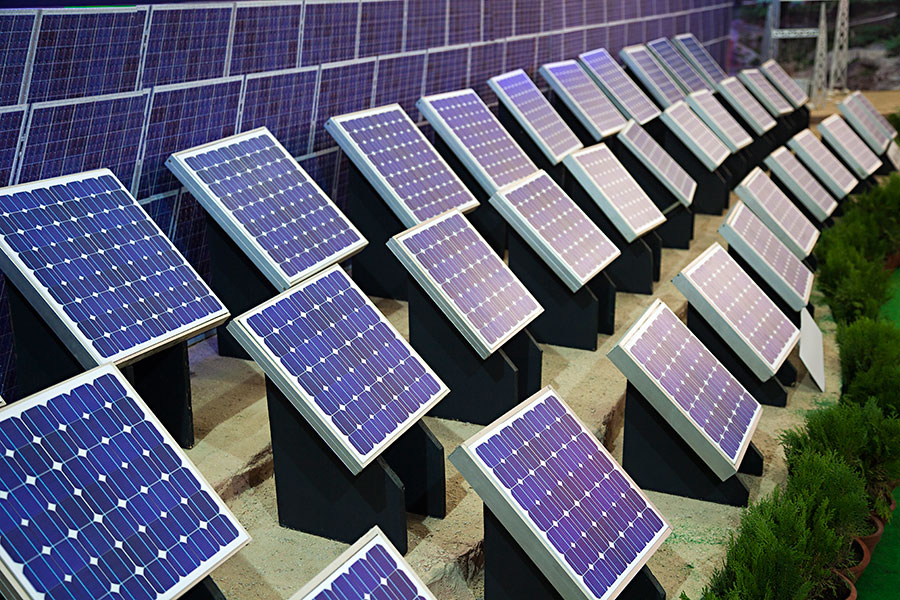Solar panels PV module includes solar cells, glass, EVA, back sheet, and frame. Learn more about components and the process of making a solar panel.
There are 3 types of solar panels available in the market
- Monocrystalline solar panels
- Polycrystalline solar panels
- Thin-film solar panels
- Mono PERC Solar Panel
Therefore, at the cellular level, there are a variety of materials for manufacture, such as mono silicon, polysilicon, or amorphous silicon (ANSI).
The first 2 types of cells have a somewhat similar production process. Read below about the stages of producing a crystalline solar panel.
The mono PERC solar panel is made of mono perc particles, which gives a high efficiency of up to 20%. It is the newest technology solar panel, which works even in low light and cloudy weather.
Also Read: Electric Vehicles with Solar Panels is going to be the Most Fuel-efficient System by 2025
The cells inside the solar panel are made of A grade, antipid cells. It is the best solar panel in mono crystalline technology, it comes with 5 busbars and 72 cells and a 25 year performance warranty.
An IP68 rated junction box is provided with the MC4 connector for high module capacity.
Step 1: Sand
It all starts with the raw material, which in our case is sand. Most solar panels are made of silicone, which is a major component of natural beach sand.
Silicon is abundant, the second most abundant element on earth. However, converting sand to high-grade silicon comes at a high cost and is an energy efficient process.
Pure Form of silicon is produced from quartz sand in an arc furnace at very high temperatures.
Step 2: Ingots
Silicon that is collected, usually in the form of solid rocks. Hundreds of these stones melt together at very high temperatures to form cylindrical rods.
To reach the desired shape, steel, cylindrical furnace is used.
During the melting process, care is taken to ensure that all the molecules are perfectly aligned in the desired structure and orientation.
Boron is added to this process, which gives the silicon a positive electrical polarity.
Monocrystalline particles are made from a single crystal of silicon.
Mono silicon has high efficiency in converting solar energy into electricity, so the cost of monocrystalline panels is high.
Polysilicon particles are made by melting many silicon crystals. You can detect the appearance of broken glass given the different silicon crystals.
After the rod has cooled, grinding and polishing is carried out, leaving the rod on flat sides.
Step 3: Layers
The layers represent the next step in the manufacturing process. The silicone rod is cut into thin discs, also known as layers.
A wire chainsaw is used for precise cutting. The thinning of the layer is similar to that of a piece of paper.
Since pure silicone is shiny, it reflects sunlight. To reduce the amount of sunlight lost, an anti-reflective coating is placed over the silicone membrane.
Step 4: Solar cells
The following processes convert a membrane into a solar cell capable of converting solar energy into electricity.
Each layer is treated and metal conductors are attached to each surface. The conductors give a grid-like matrix to the layer on the surface.
This ensures the conversion of solar energy into electricity. The coating helps to absorb without reflecting sunlight.
In a fireplace-like room, phosphorus is spread in a thin layer on the surface of the layers. It charges the surface with a negative electric current.
The combination of boron and phosphorus gives a positive-negative junction, which is crucial for the proper functioning of the PV cell.
Step 5: From the solar cell to the solar panel
Solar cells are held together using metal connectors to connect the cells. Solar panels are made of solar cells integrated into a matrix-like structure.
Current standard offering in the market
- 48 cell panels – Suitable for small residential roofs.
- 60-cell panels – this is the standard size.
- 72-cell panels used for large-scale installations. Lg Panel 11
The most common sizing system in terms of kWh for USA homes is the 4 kWh solar system.
After mixing the particles, a thin layer (approximately 6-7 mm) of glass is attached to the front, facing the sun.
The back sheet is made from a very durable, polymer based material. This prevents water, soil and other materials from entering the panel from behind.
Next, to enable connections inside the module, a junction box is added.
All of these come together after the frame is assembled. The frame also provides protection from impact and weather.
The use of the frame also allows the mounting of the panel in different ways, for example with mounting clamps.
EVA (Ethylene Vinyl Acetate) is an all-in-one glue. It is important that the quality of the encapsulant is high so that it does not damage the cells in harsh weather conditions.
Step 6: Test the modules
Once the module is ready, the cells are tested to make sure they are working properly. STC (Standard Test Conditions) is used as the reference point.
The panel is placed in a flash tester at the manufacturing facility. Tester 1000W / m2 irradiance, equivalent to 25 ° C cell temperature and 1.5 g air mass.
Electrical parameters are written and you can find these results in the technical description sheet of each panel.
Ratings reveal power generation, capacity, voltage, current, impact, and temperature tolerance.
Unlike STC, each manufacturer uses NOCT (Nominal Operating Cell Temperature).
The parameters used are close to the ‘real life’ scenario: open-circuit module operation temperature at 800W / m2 irradiance, the ambient temperature of 20 ° C, wind speed of 1m / s.
Again, NOCT’s ratings can be found in the Technical Specification Sheet.
The final stages of production are cleaning and inspecting the module before it is ready to be shipped to homes or businesses.
Research and development in the solar energy industry aims to reduce the cost of solar panels and increase efficiency.
The solar panel manufacturing industry is expected to become more competitive and more popular than conventional energy sources such as fossil fuels.




